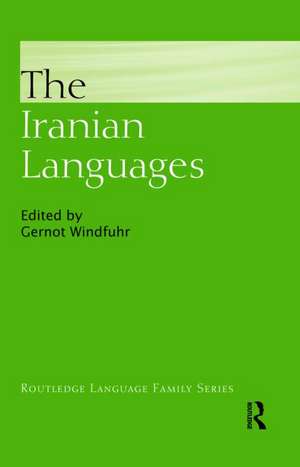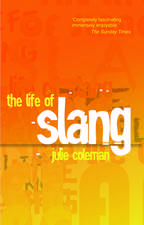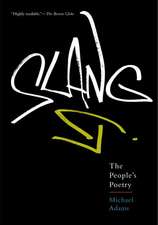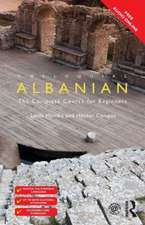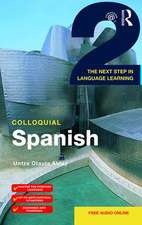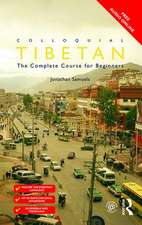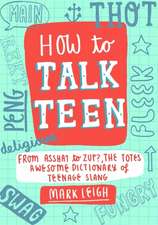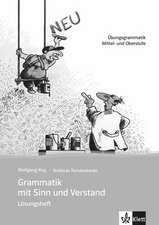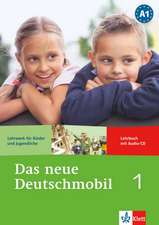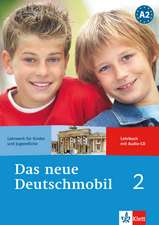The Iranian Languages: Routledge Language Family Series
Editat de Gernot Windfuhren Limba Engleză Hardback – 21 dec 2009
The Iranian Languages is divided into fifteen chapters. The introductory chapters by the editor present a general overview and a detailed discussion of the linguistic typology of Iranian. The individual chapters which follow are written by leading experts in the field. These provide the reader with concise, non-technical descriptions of a range of Iranian languages. Each chapter follows the same pattern and sequence of topics, taking the reader through the significant features not only of phonology and morphology but also of syntax; from phrase level to complex sentences and pragmatics.
Ample examples on all levels are provided with detailed annotation for the non-specialist reader. In addition, each chapter covers lexis, sociolinguistic and typological issues, and concludes with annotated sample texts.
This unique resource is the ideal companion for undergraduate and postgraduate students of linguistics and language. It will also be of interest to researchers or anyone with an interest in historical linguistics, linguistics anthropology and language development.
Gernot Windfuhr is Professor of Iranian Studies at the University of Michigan; he has published widely on Persian and Iranian languages and linguistics and related languages, as well as on other aspects of Iranian culture including Persian literature and Pre-Islamic Iranian religions.
| Toate formatele și edițiile | Preț | Express |
|---|---|---|
| Paperback (1) | 649.50 lei 6-8 săpt. | |
| Taylor & Francis – 12 iul 2012 | 649.50 lei 6-8 săpt. | |
| Hardback (1) | 2780.74 lei 6-8 săpt. | |
| Taylor & Francis – 21 dec 2009 | 2780.74 lei 6-8 săpt. |
Din seria Routledge Language Family Series
- 15%
 Preț: 556.11 lei
Preț: 556.11 lei - 16%
 Preț: 299.52 lei
Preț: 299.52 lei -
 Preț: 356.94 lei
Preț: 356.94 lei -
 Preț: 363.11 lei
Preț: 363.11 lei - 8%
 Preț: 497.74 lei
Preț: 497.74 lei -
 Preț: 349.03 lei
Preț: 349.03 lei - 15%
 Preț: 595.94 lei
Preț: 595.94 lei - 15%
 Preț: 649.50 lei
Preț: 649.50 lei - 15%
 Preț: 640.02 lei
Preț: 640.02 lei - 15%
 Preț: 437.34 lei
Preț: 437.34 lei - 9%
 Preț: 572.71 lei
Preț: 572.71 lei - 18%
 Preț: 733.92 lei
Preț: 733.92 lei - 15%
 Preț: 687.11 lei
Preț: 687.11 lei - 9%
 Preț: 2244.57 lei
Preț: 2244.57 lei - 15%
 Preț: 692.84 lei
Preț: 692.84 lei - 15%
 Preț: 591.62 lei
Preț: 591.62 lei -
 Preț: 416.22 lei
Preț: 416.22 lei -
 Preț: 348.41 lei
Preț: 348.41 lei - 15%
 Preț: 577.30 lei
Preț: 577.30 lei - 15%
 Preț: 632.05 lei
Preț: 632.05 lei - 20%
 Preț: 348.08 lei
Preț: 348.08 lei - 8%
 Preț: 495.74 lei
Preț: 495.74 lei - 15%
 Preț: 543.52 lei
Preț: 543.52 lei - 18%
 Preț: 1564.55 lei
Preț: 1564.55 lei - 15%
 Preț: 604.91 lei
Preț: 604.91 lei - 18%
 Preț: 2896.35 lei
Preț: 2896.35 lei
Preț: 2780.74 lei
Preț vechi: 3391.14 lei
-18% Nou
Puncte Express: 4171
Preț estimativ în valută:
532.26€ • 578.35$ • 447.39£
532.26€ • 578.35$ • 447.39£
Carte tipărită la comandă
Livrare economică 21 aprilie-05 mai
Preluare comenzi: 021 569.72.76
Specificații
ISBN-13: 9780700711314
ISBN-10: 0700711317
Pagini: 948
Ilustrații: 187 tables and 12 halftones
Dimensiuni: 156 x 234 x 63 mm
Greutate: 1.54 kg
Ediția:1
Editura: Taylor & Francis
Colecția Routledge
Seria Routledge Language Family Series
Locul publicării:Oxford, United Kingdom
ISBN-10: 0700711317
Pagini: 948
Ilustrații: 187 tables and 12 halftones
Dimensiuni: 156 x 234 x 63 mm
Greutate: 1.54 kg
Ediția:1
Editura: Taylor & Francis
Colecția Routledge
Seria Routledge Language Family Series
Locul publicării:Oxford, United Kingdom
Public țintă
Postgraduate and UndergraduateCuprins
Old Iranian. Middle Iranian. New West Iranian Languages. New East Iranian Languages. General References. Index. Maps
Recenzii
'This volume provides for the first time a detailed overview of the Iranian languages that is up-to-date in its coverage and accessible to a wide range of readers, whether their interests are primarily in language structure, in history of language - in its own right or in conjunction with non-linguistic historical events - or in the processes and results of language contact.
Iranian languages are spoken from central Turkey in the west to westernmost China in the east, and include the national languages Persian (with its national varieties Dari in Afghanistan and Tajik in Tajikistan) and Pashto (in Afghanistan), other widely spoken languages such as Kurdish (mainly Iraq, Iran, and Turkey) and Balochi (mainly Pakistan), as well as languages on the verge of extinction (such as Parachi, with about 3500 speakers in northeastern Afghanistan). In the historical dimension, they span three millennia, from Avestan (the language of the holy scriptures of Zoroastrianism) and Old Persian (the language of Darius the Great) through important medieval languages like Sogdian to the present day. The volume includes detailed descriptions of modern languages from each of the four major divisions of the family (Northwestern, Southwestern, Northeastern, and Southeastern).
Unlike most earlier literature aimed primarily at specialists, this volume presents material in a widely accessible manner. And unlike much earlier literature which concentrates on phonology and morphology, the present volume, while doing full justice to these areas, also provides for the first time extensive comparative information on syntax. The syntax of the Iranian languages presents much that will be of interest to typologists and formal grammarians, with pride of place surely going to ergativity - the astonishing variations found on ergativity in Iranian languages is a goldmine for the comparative syntactician. But other phenomena will appeal equally, for instance the transformation of tense-aspect-mood systems across the Iranian languages, or the appearance of vigesimal (20-based) numeral systems.
The volume also provides extensive information on the historical and areal contexts in which the various Iranian languages have lived. Discussion of language contact of course includes loanwords, but also documents the shifts in structural patterns that have occurred as Iranian languages have come into contact with other languages, including languages with structures as different from Iranian as the Turkic languages.
This is the volume I wish I'd had when Iranian languages first aroused my interest nearly 40 years ago!' - Bernard Comrie, Max Planck Institute for Evolutionary Anthropology, Germany
Iranian languages are spoken from central Turkey in the west to westernmost China in the east, and include the national languages Persian (with its national varieties Dari in Afghanistan and Tajik in Tajikistan) and Pashto (in Afghanistan), other widely spoken languages such as Kurdish (mainly Iraq, Iran, and Turkey) and Balochi (mainly Pakistan), as well as languages on the verge of extinction (such as Parachi, with about 3500 speakers in northeastern Afghanistan). In the historical dimension, they span three millennia, from Avestan (the language of the holy scriptures of Zoroastrianism) and Old Persian (the language of Darius the Great) through important medieval languages like Sogdian to the present day. The volume includes detailed descriptions of modern languages from each of the four major divisions of the family (Northwestern, Southwestern, Northeastern, and Southeastern).
Unlike most earlier literature aimed primarily at specialists, this volume presents material in a widely accessible manner. And unlike much earlier literature which concentrates on phonology and morphology, the present volume, while doing full justice to these areas, also provides for the first time extensive comparative information on syntax. The syntax of the Iranian languages presents much that will be of interest to typologists and formal grammarians, with pride of place surely going to ergativity - the astonishing variations found on ergativity in Iranian languages is a goldmine for the comparative syntactician. But other phenomena will appeal equally, for instance the transformation of tense-aspect-mood systems across the Iranian languages, or the appearance of vigesimal (20-based) numeral systems.
The volume also provides extensive information on the historical and areal contexts in which the various Iranian languages have lived. Discussion of language contact of course includes loanwords, but also documents the shifts in structural patterns that have occurred as Iranian languages have come into contact with other languages, including languages with structures as different from Iranian as the Turkic languages.
This is the volume I wish I'd had when Iranian languages first aroused my interest nearly 40 years ago!' - Bernard Comrie, Max Planck Institute for Evolutionary Anthropology, Germany
Descriere
'This is the volume I wish I'd had when Iranian languages first aroused my interest nearly 40 years ago!' - Bernard Comrie, Max Planck Institute for Evolutionary Anthropology, Germany
The Iranian Languages is divided into 15 chapters. The introductory chapters by the editor present a general overview and a detailed discussion of the linguistic typology of Iranian. The individual chapters which follow are written by leading experts in the field. These provide the reader with concise, non-technical descriptions of a range of Iranian languages. Each chapter follows the same pattern and sequence of topics, taking the reader through the significant features not only of phonology and morphology but also of syntax; from phrase level to complex sentences and pragmatics.
This unique resource is the ideal companion for undergraduate and postgraduate students of linguistics and language. It will also be of interest to researchers or anyone with an interest in historical linguistics, linguistics anthropology and language development.
The Iranian Languages is divided into 15 chapters. The introductory chapters by the editor present a general overview and a detailed discussion of the linguistic typology of Iranian. The individual chapters which follow are written by leading experts in the field. These provide the reader with concise, non-technical descriptions of a range of Iranian languages. Each chapter follows the same pattern and sequence of topics, taking the reader through the significant features not only of phonology and morphology but also of syntax; from phrase level to complex sentences and pragmatics.
This unique resource is the ideal companion for undergraduate and postgraduate students of linguistics and language. It will also be of interest to researchers or anyone with an interest in historical linguistics, linguistics anthropology and language development.
